Theory about Ethics and Governance 2022
VerifiedAdded on 2022/10/04
|15
|4108
|26
AI Summary
Contribute Materials
Your contribution can guide someone’s learning journey. Share your
documents today.
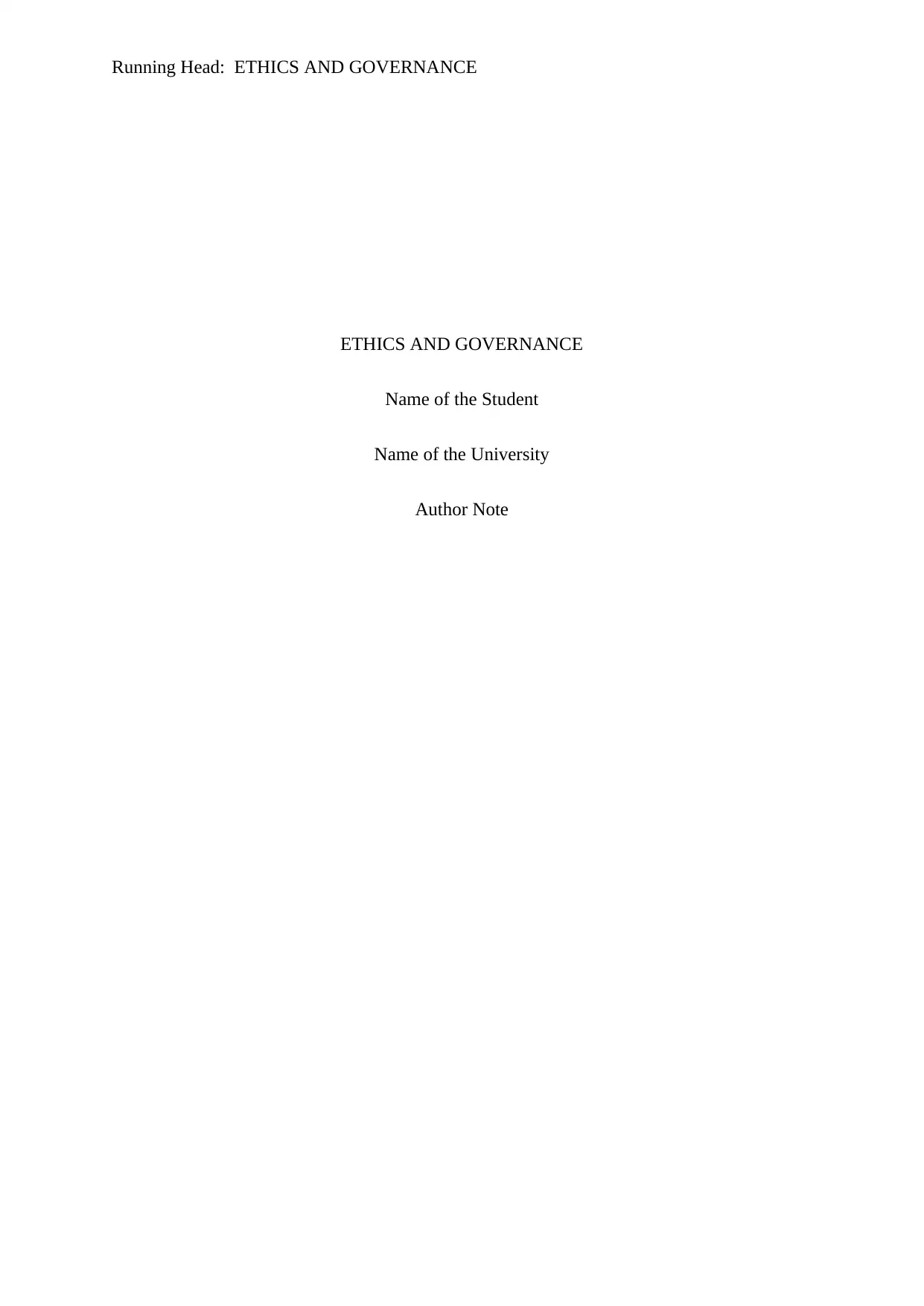
Running Head: ETHICS AND GOVERNANCE
ETHICS AND GOVERNANCE
Name of the Student
Name of the University
Author Note
ETHICS AND GOVERNANCE
Name of the Student
Name of the University
Author Note
Secure Best Marks with AI Grader
Need help grading? Try our AI Grader for instant feedback on your assignments.
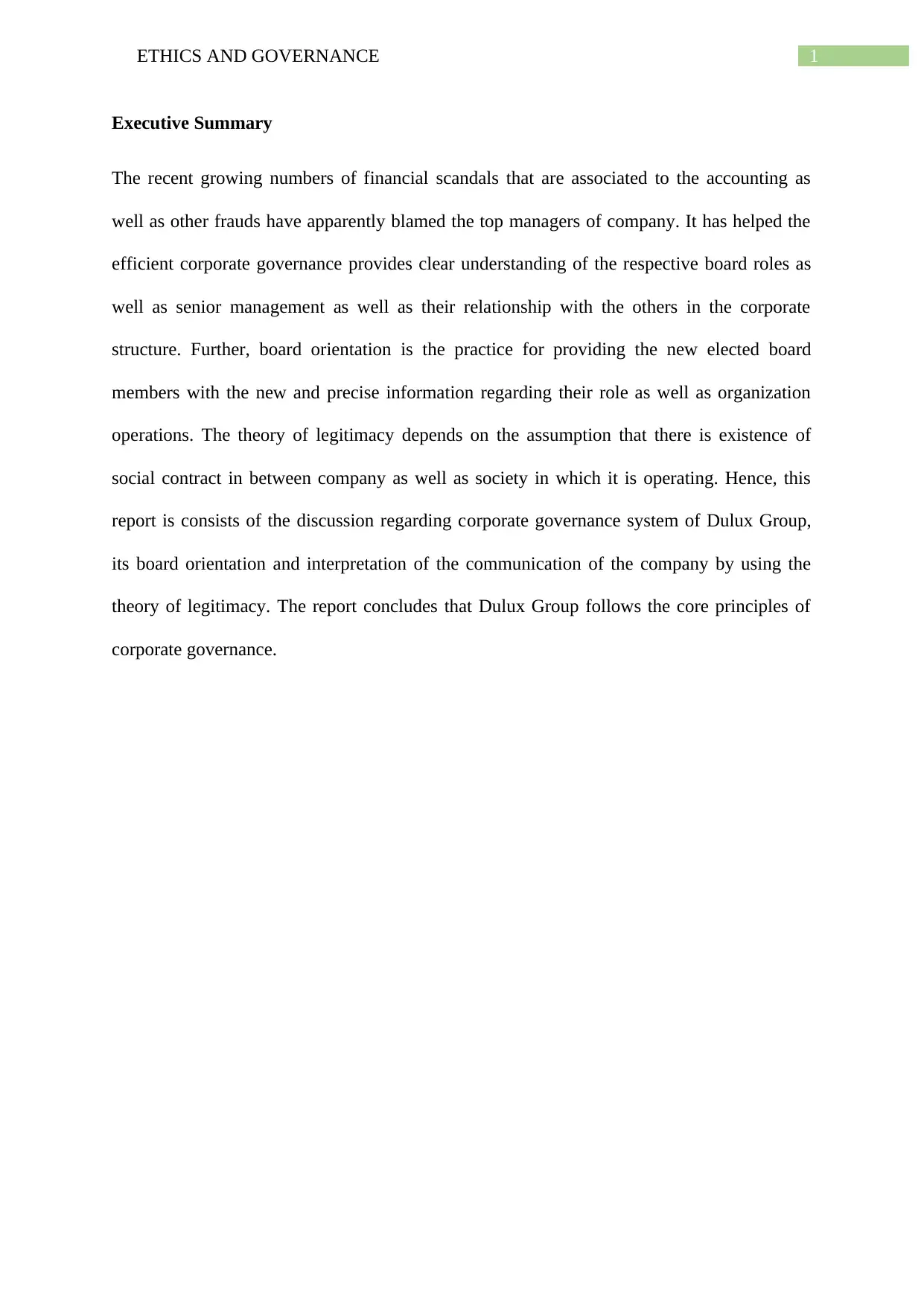
1ETHICS AND GOVERNANCE
Executive Summary
The recent growing numbers of financial scandals that are associated to the accounting as
well as other frauds have apparently blamed the top managers of company. It has helped the
efficient corporate governance provides clear understanding of the respective board roles as
well as senior management as well as their relationship with the others in the corporate
structure. Further, board orientation is the practice for providing the new elected board
members with the new and precise information regarding their role as well as organization
operations. The theory of legitimacy depends on the assumption that there is existence of
social contract in between company as well as society in which it is operating. Hence, this
report is consists of the discussion regarding corporate governance system of Dulux Group,
its board orientation and interpretation of the communication of the company by using the
theory of legitimacy. The report concludes that Dulux Group follows the core principles of
corporate governance.
Executive Summary
The recent growing numbers of financial scandals that are associated to the accounting as
well as other frauds have apparently blamed the top managers of company. It has helped the
efficient corporate governance provides clear understanding of the respective board roles as
well as senior management as well as their relationship with the others in the corporate
structure. Further, board orientation is the practice for providing the new elected board
members with the new and precise information regarding their role as well as organization
operations. The theory of legitimacy depends on the assumption that there is existence of
social contract in between company as well as society in which it is operating. Hence, this
report is consists of the discussion regarding corporate governance system of Dulux Group,
its board orientation and interpretation of the communication of the company by using the
theory of legitimacy. The report concludes that Dulux Group follows the core principles of
corporate governance.
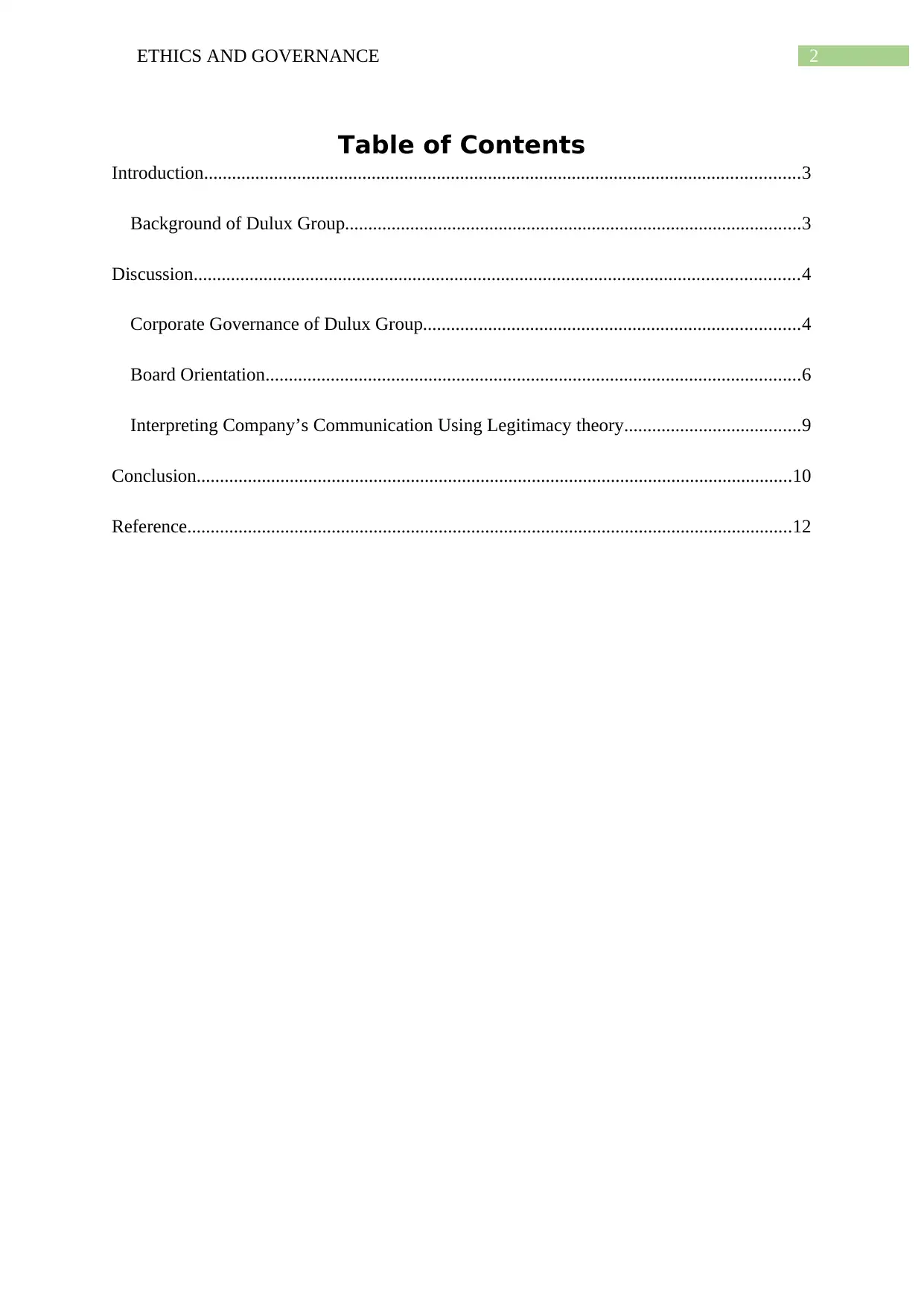
2ETHICS AND GOVERNANCE
Table of Contents
Introduction................................................................................................................................3
Background of Dulux Group..................................................................................................3
Discussion..................................................................................................................................4
Corporate Governance of Dulux Group.................................................................................4
Board Orientation...................................................................................................................6
Interpreting Company’s Communication Using Legitimacy theory......................................9
Conclusion................................................................................................................................10
Reference..................................................................................................................................12
Table of Contents
Introduction................................................................................................................................3
Background of Dulux Group..................................................................................................3
Discussion..................................................................................................................................4
Corporate Governance of Dulux Group.................................................................................4
Board Orientation...................................................................................................................6
Interpreting Company’s Communication Using Legitimacy theory......................................9
Conclusion................................................................................................................................10
Reference..................................................................................................................................12
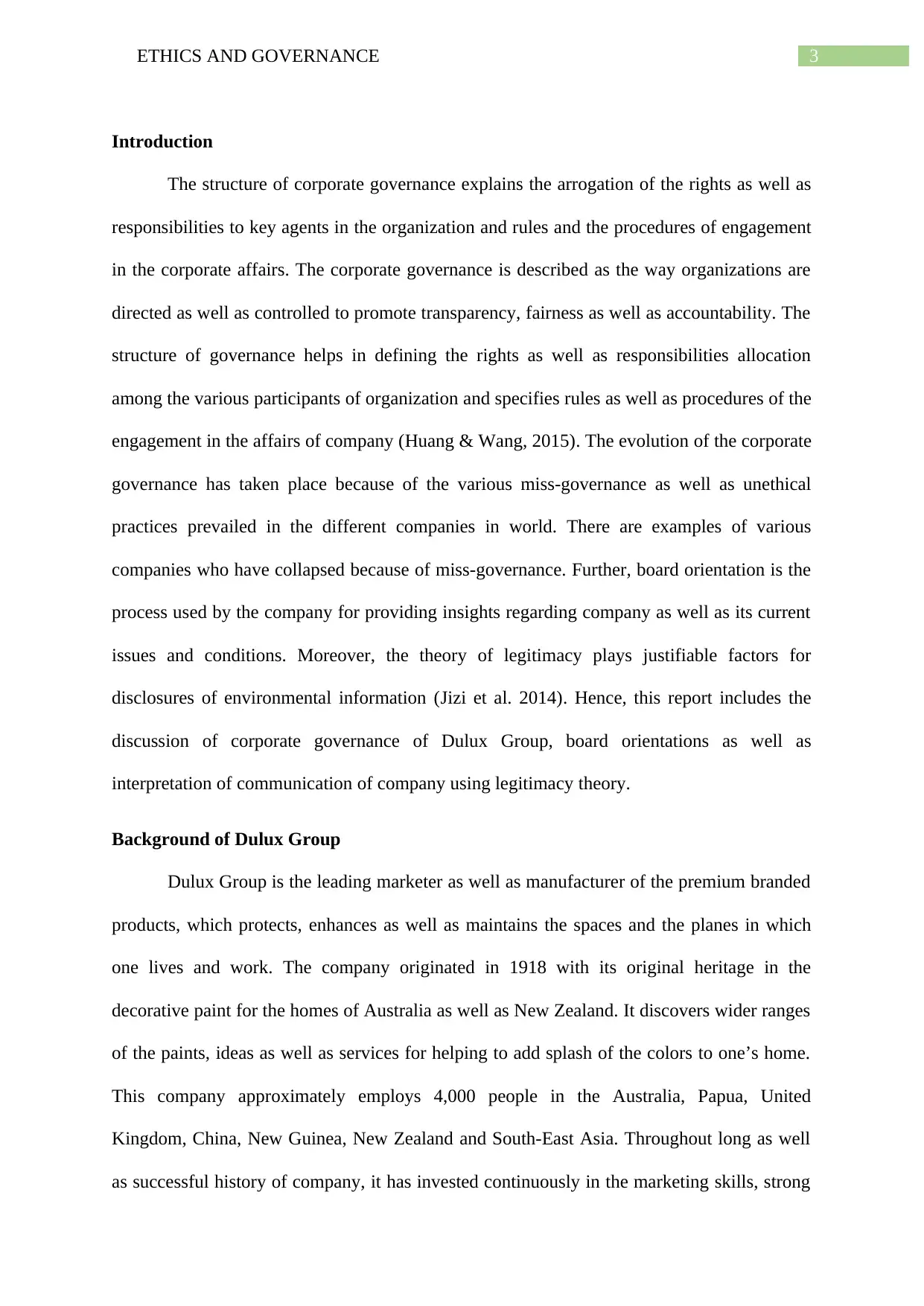
3ETHICS AND GOVERNANCE
Introduction
The structure of corporate governance explains the arrogation of the rights as well as
responsibilities to key agents in the organization and rules and the procedures of engagement
in the corporate affairs. The corporate governance is described as the way organizations are
directed as well as controlled to promote transparency, fairness as well as accountability. The
structure of governance helps in defining the rights as well as responsibilities allocation
among the various participants of organization and specifies rules as well as procedures of the
engagement in the affairs of company (Huang & Wang, 2015). The evolution of the corporate
governance has taken place because of the various miss-governance as well as unethical
practices prevailed in the different companies in world. There are examples of various
companies who have collapsed because of miss-governance. Further, board orientation is the
process used by the company for providing insights regarding company as well as its current
issues and conditions. Moreover, the theory of legitimacy plays justifiable factors for
disclosures of environmental information (Jizi et al. 2014). Hence, this report includes the
discussion of corporate governance of Dulux Group, board orientations as well as
interpretation of communication of company using legitimacy theory.
Background of Dulux Group
Dulux Group is the leading marketer as well as manufacturer of the premium branded
products, which protects, enhances as well as maintains the spaces and the planes in which
one lives and work. The company originated in 1918 with its original heritage in the
decorative paint for the homes of Australia as well as New Zealand. It discovers wider ranges
of the paints, ideas as well as services for helping to add splash of the colors to one’s home.
This company approximately employs 4,000 people in the Australia, Papua, United
Kingdom, China, New Guinea, New Zealand and South-East Asia. Throughout long as well
as successful history of company, it has invested continuously in the marketing skills, strong
Introduction
The structure of corporate governance explains the arrogation of the rights as well as
responsibilities to key agents in the organization and rules and the procedures of engagement
in the corporate affairs. The corporate governance is described as the way organizations are
directed as well as controlled to promote transparency, fairness as well as accountability. The
structure of governance helps in defining the rights as well as responsibilities allocation
among the various participants of organization and specifies rules as well as procedures of the
engagement in the affairs of company (Huang & Wang, 2015). The evolution of the corporate
governance has taken place because of the various miss-governance as well as unethical
practices prevailed in the different companies in world. There are examples of various
companies who have collapsed because of miss-governance. Further, board orientation is the
process used by the company for providing insights regarding company as well as its current
issues and conditions. Moreover, the theory of legitimacy plays justifiable factors for
disclosures of environmental information (Jizi et al. 2014). Hence, this report includes the
discussion of corporate governance of Dulux Group, board orientations as well as
interpretation of communication of company using legitimacy theory.
Background of Dulux Group
Dulux Group is the leading marketer as well as manufacturer of the premium branded
products, which protects, enhances as well as maintains the spaces and the planes in which
one lives and work. The company originated in 1918 with its original heritage in the
decorative paint for the homes of Australia as well as New Zealand. It discovers wider ranges
of the paints, ideas as well as services for helping to add splash of the colors to one’s home.
This company approximately employs 4,000 people in the Australia, Papua, United
Kingdom, China, New Guinea, New Zealand and South-East Asia. Throughout long as well
as successful history of company, it has invested continuously in the marketing skills, strong
Secure Best Marks with AI Grader
Need help grading? Try our AI Grader for instant feedback on your assignments.
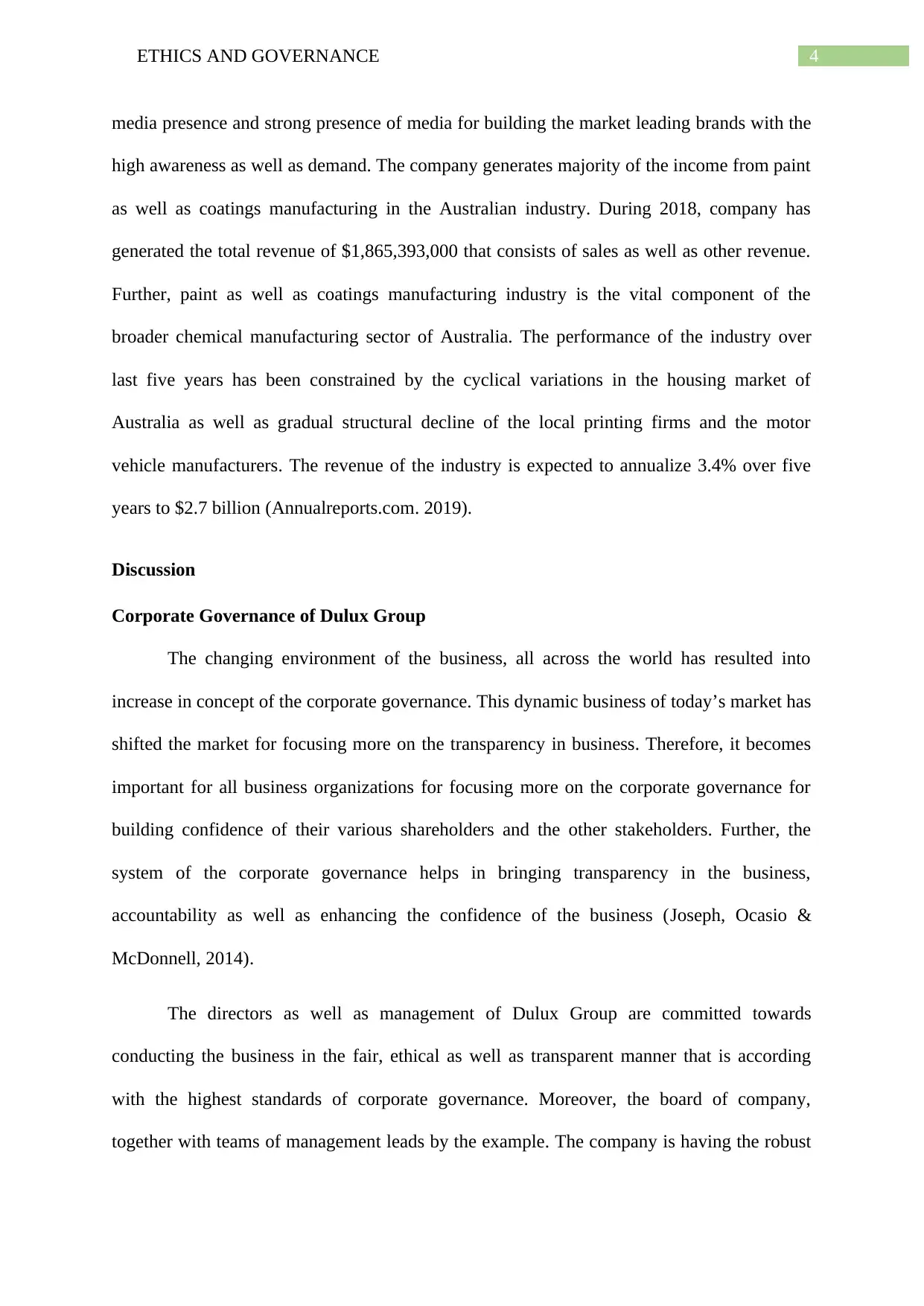
4ETHICS AND GOVERNANCE
media presence and strong presence of media for building the market leading brands with the
high awareness as well as demand. The company generates majority of the income from paint
as well as coatings manufacturing in the Australian industry. During 2018, company has
generated the total revenue of $1,865,393,000 that consists of sales as well as other revenue.
Further, paint as well as coatings manufacturing industry is the vital component of the
broader chemical manufacturing sector of Australia. The performance of the industry over
last five years has been constrained by the cyclical variations in the housing market of
Australia as well as gradual structural decline of the local printing firms and the motor
vehicle manufacturers. The revenue of the industry is expected to annualize 3.4% over five
years to $2.7 billion (Annualreports.com. 2019).
Discussion
Corporate Governance of Dulux Group
The changing environment of the business, all across the world has resulted into
increase in concept of the corporate governance. This dynamic business of today’s market has
shifted the market for focusing more on the transparency in business. Therefore, it becomes
important for all business organizations for focusing more on the corporate governance for
building confidence of their various shareholders and the other stakeholders. Further, the
system of the corporate governance helps in bringing transparency in the business,
accountability as well as enhancing the confidence of the business (Joseph, Ocasio &
McDonnell, 2014).
The directors as well as management of Dulux Group are committed towards
conducting the business in the fair, ethical as well as transparent manner that is according
with the highest standards of corporate governance. Moreover, the board of company,
together with teams of management leads by the example. The company is having the robust
media presence and strong presence of media for building the market leading brands with the
high awareness as well as demand. The company generates majority of the income from paint
as well as coatings manufacturing in the Australian industry. During 2018, company has
generated the total revenue of $1,865,393,000 that consists of sales as well as other revenue.
Further, paint as well as coatings manufacturing industry is the vital component of the
broader chemical manufacturing sector of Australia. The performance of the industry over
last five years has been constrained by the cyclical variations in the housing market of
Australia as well as gradual structural decline of the local printing firms and the motor
vehicle manufacturers. The revenue of the industry is expected to annualize 3.4% over five
years to $2.7 billion (Annualreports.com. 2019).
Discussion
Corporate Governance of Dulux Group
The changing environment of the business, all across the world has resulted into
increase in concept of the corporate governance. This dynamic business of today’s market has
shifted the market for focusing more on the transparency in business. Therefore, it becomes
important for all business organizations for focusing more on the corporate governance for
building confidence of their various shareholders and the other stakeholders. Further, the
system of the corporate governance helps in bringing transparency in the business,
accountability as well as enhancing the confidence of the business (Joseph, Ocasio &
McDonnell, 2014).
The directors as well as management of Dulux Group are committed towards
conducting the business in the fair, ethical as well as transparent manner that is according
with the highest standards of corporate governance. Moreover, the board of company,
together with teams of management leads by the example. The company is having the robust
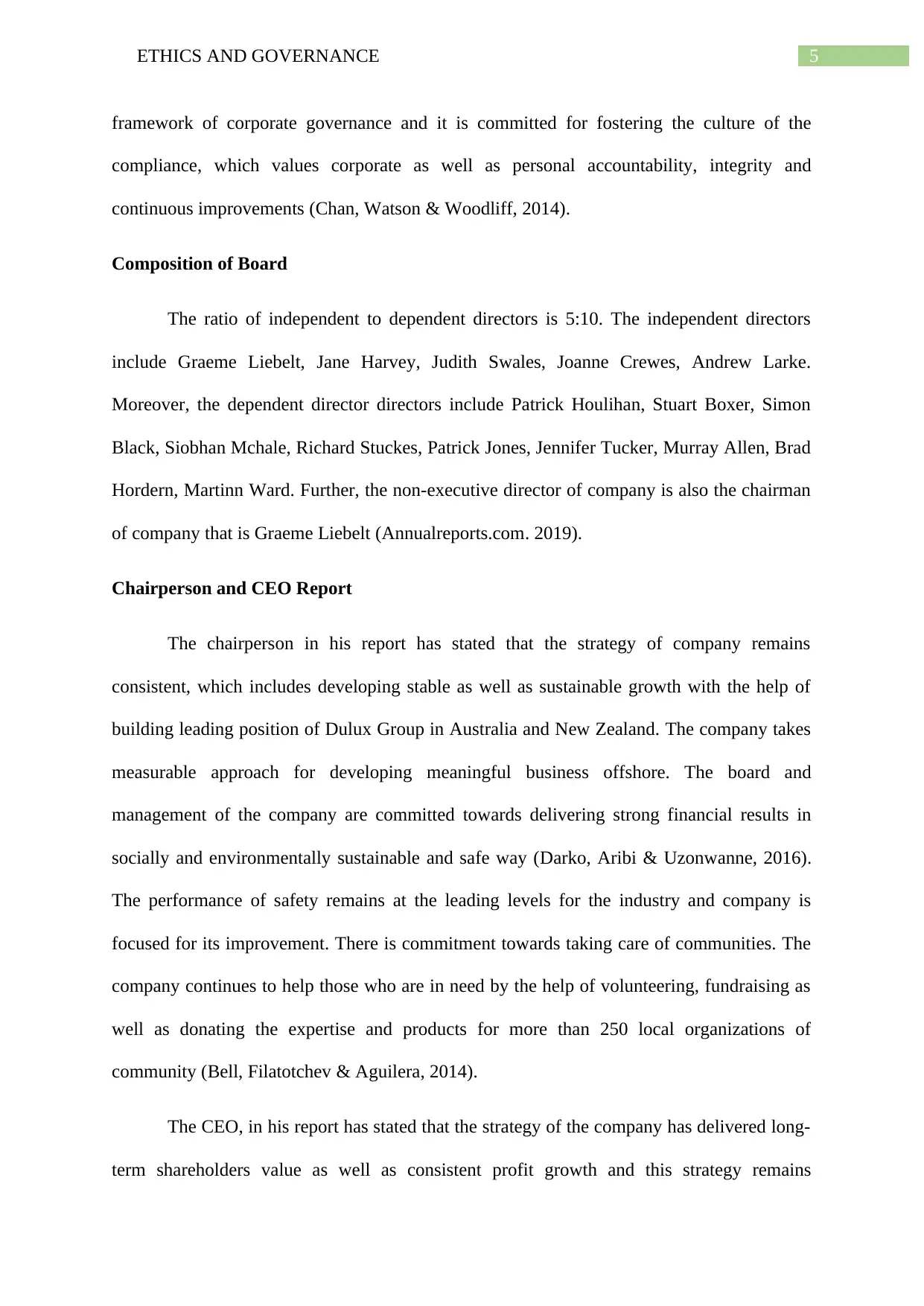
5ETHICS AND GOVERNANCE
framework of corporate governance and it is committed for fostering the culture of the
compliance, which values corporate as well as personal accountability, integrity and
continuous improvements (Chan, Watson & Woodliff, 2014).
Composition of Board
The ratio of independent to dependent directors is 5:10. The independent directors
include Graeme Liebelt, Jane Harvey, Judith Swales, Joanne Crewes, Andrew Larke.
Moreover, the dependent director directors include Patrick Houlihan, Stuart Boxer, Simon
Black, Siobhan Mchale, Richard Stuckes, Patrick Jones, Jennifer Tucker, Murray Allen, Brad
Hordern, Martinn Ward. Further, the non-executive director of company is also the chairman
of company that is Graeme Liebelt (Annualreports.com. 2019).
Chairperson and CEO Report
The chairperson in his report has stated that the strategy of company remains
consistent, which includes developing stable as well as sustainable growth with the help of
building leading position of Dulux Group in Australia and New Zealand. The company takes
measurable approach for developing meaningful business offshore. The board and
management of the company are committed towards delivering strong financial results in
socially and environmentally sustainable and safe way (Darko, Aribi & Uzonwanne, 2016).
The performance of safety remains at the leading levels for the industry and company is
focused for its improvement. There is commitment towards taking care of communities. The
company continues to help those who are in need by the help of volunteering, fundraising as
well as donating the expertise and products for more than 250 local organizations of
community (Bell, Filatotchev & Aguilera, 2014).
The CEO, in his report has stated that the strategy of the company has delivered long-
term shareholders value as well as consistent profit growth and this strategy remains
framework of corporate governance and it is committed for fostering the culture of the
compliance, which values corporate as well as personal accountability, integrity and
continuous improvements (Chan, Watson & Woodliff, 2014).
Composition of Board
The ratio of independent to dependent directors is 5:10. The independent directors
include Graeme Liebelt, Jane Harvey, Judith Swales, Joanne Crewes, Andrew Larke.
Moreover, the dependent director directors include Patrick Houlihan, Stuart Boxer, Simon
Black, Siobhan Mchale, Richard Stuckes, Patrick Jones, Jennifer Tucker, Murray Allen, Brad
Hordern, Martinn Ward. Further, the non-executive director of company is also the chairman
of company that is Graeme Liebelt (Annualreports.com. 2019).
Chairperson and CEO Report
The chairperson in his report has stated that the strategy of company remains
consistent, which includes developing stable as well as sustainable growth with the help of
building leading position of Dulux Group in Australia and New Zealand. The company takes
measurable approach for developing meaningful business offshore. The board and
management of the company are committed towards delivering strong financial results in
socially and environmentally sustainable and safe way (Darko, Aribi & Uzonwanne, 2016).
The performance of safety remains at the leading levels for the industry and company is
focused for its improvement. There is commitment towards taking care of communities. The
company continues to help those who are in need by the help of volunteering, fundraising as
well as donating the expertise and products for more than 250 local organizations of
community (Bell, Filatotchev & Aguilera, 2014).
The CEO, in his report has stated that the strategy of the company has delivered long-
term shareholders value as well as consistent profit growth and this strategy remains
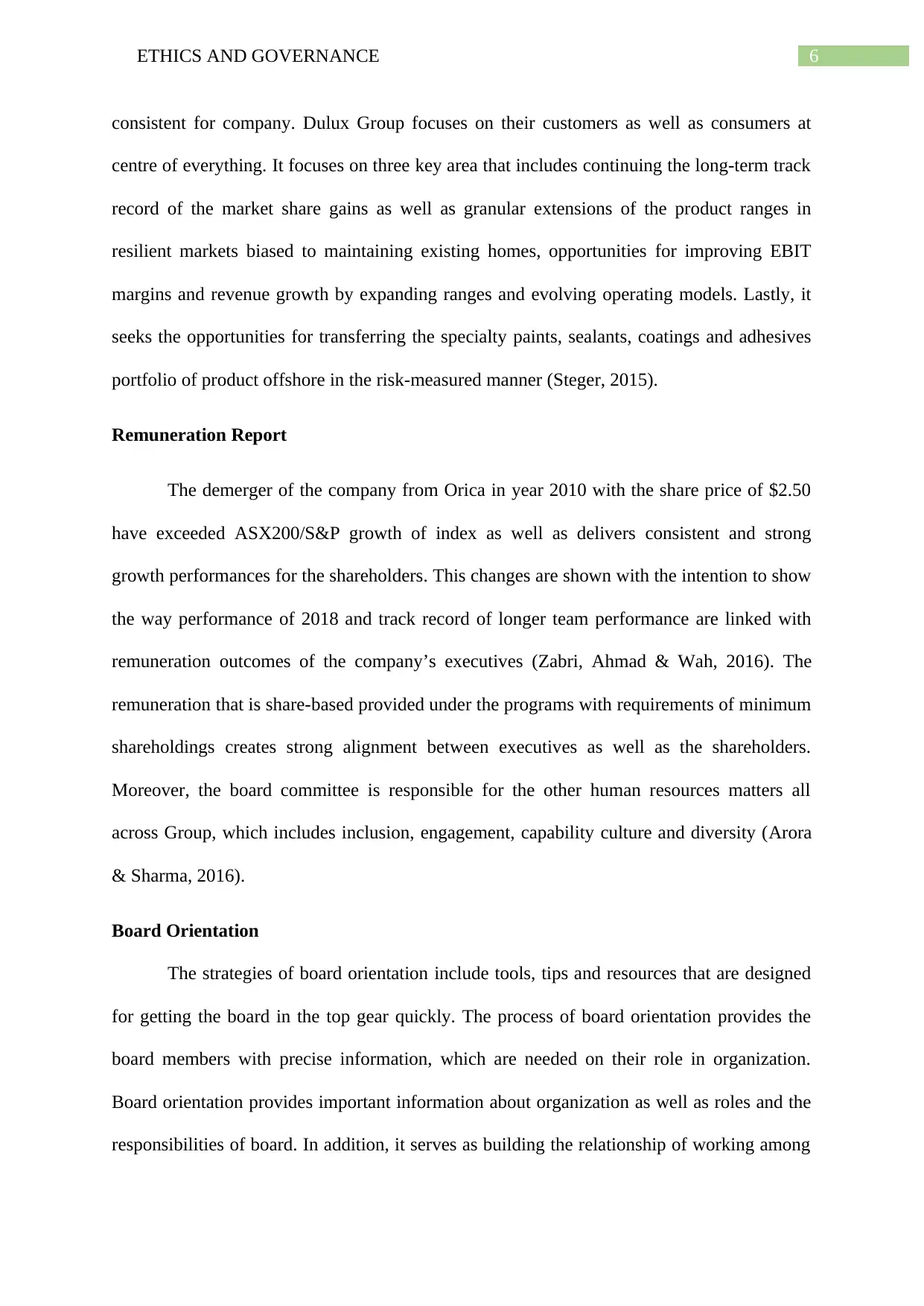
6ETHICS AND GOVERNANCE
consistent for company. Dulux Group focuses on their customers as well as consumers at
centre of everything. It focuses on three key area that includes continuing the long-term track
record of the market share gains as well as granular extensions of the product ranges in
resilient markets biased to maintaining existing homes, opportunities for improving EBIT
margins and revenue growth by expanding ranges and evolving operating models. Lastly, it
seeks the opportunities for transferring the specialty paints, sealants, coatings and adhesives
portfolio of product offshore in the risk-measured manner (Steger, 2015).
Remuneration Report
The demerger of the company from Orica in year 2010 with the share price of $2.50
have exceeded ASX200/S&P growth of index as well as delivers consistent and strong
growth performances for the shareholders. This changes are shown with the intention to show
the way performance of 2018 and track record of longer team performance are linked with
remuneration outcomes of the company’s executives (Zabri, Ahmad & Wah, 2016). The
remuneration that is share-based provided under the programs with requirements of minimum
shareholdings creates strong alignment between executives as well as the shareholders.
Moreover, the board committee is responsible for the other human resources matters all
across Group, which includes inclusion, engagement, capability culture and diversity (Arora
& Sharma, 2016).
Board Orientation
The strategies of board orientation include tools, tips and resources that are designed
for getting the board in the top gear quickly. The process of board orientation provides the
board members with precise information, which are needed on their role in organization.
Board orientation provides important information about organization as well as roles and the
responsibilities of board. In addition, it serves as building the relationship of working among
consistent for company. Dulux Group focuses on their customers as well as consumers at
centre of everything. It focuses on three key area that includes continuing the long-term track
record of the market share gains as well as granular extensions of the product ranges in
resilient markets biased to maintaining existing homes, opportunities for improving EBIT
margins and revenue growth by expanding ranges and evolving operating models. Lastly, it
seeks the opportunities for transferring the specialty paints, sealants, coatings and adhesives
portfolio of product offshore in the risk-measured manner (Steger, 2015).
Remuneration Report
The demerger of the company from Orica in year 2010 with the share price of $2.50
have exceeded ASX200/S&P growth of index as well as delivers consistent and strong
growth performances for the shareholders. This changes are shown with the intention to show
the way performance of 2018 and track record of longer team performance are linked with
remuneration outcomes of the company’s executives (Zabri, Ahmad & Wah, 2016). The
remuneration that is share-based provided under the programs with requirements of minimum
shareholdings creates strong alignment between executives as well as the shareholders.
Moreover, the board committee is responsible for the other human resources matters all
across Group, which includes inclusion, engagement, capability culture and diversity (Arora
& Sharma, 2016).
Board Orientation
The strategies of board orientation include tools, tips and resources that are designed
for getting the board in the top gear quickly. The process of board orientation provides the
board members with precise information, which are needed on their role in organization.
Board orientation provides important information about organization as well as roles and the
responsibilities of board. In addition, it serves as building the relationship of working among
Paraphrase This Document
Need a fresh take? Get an instant paraphrase of this document with our AI Paraphraser
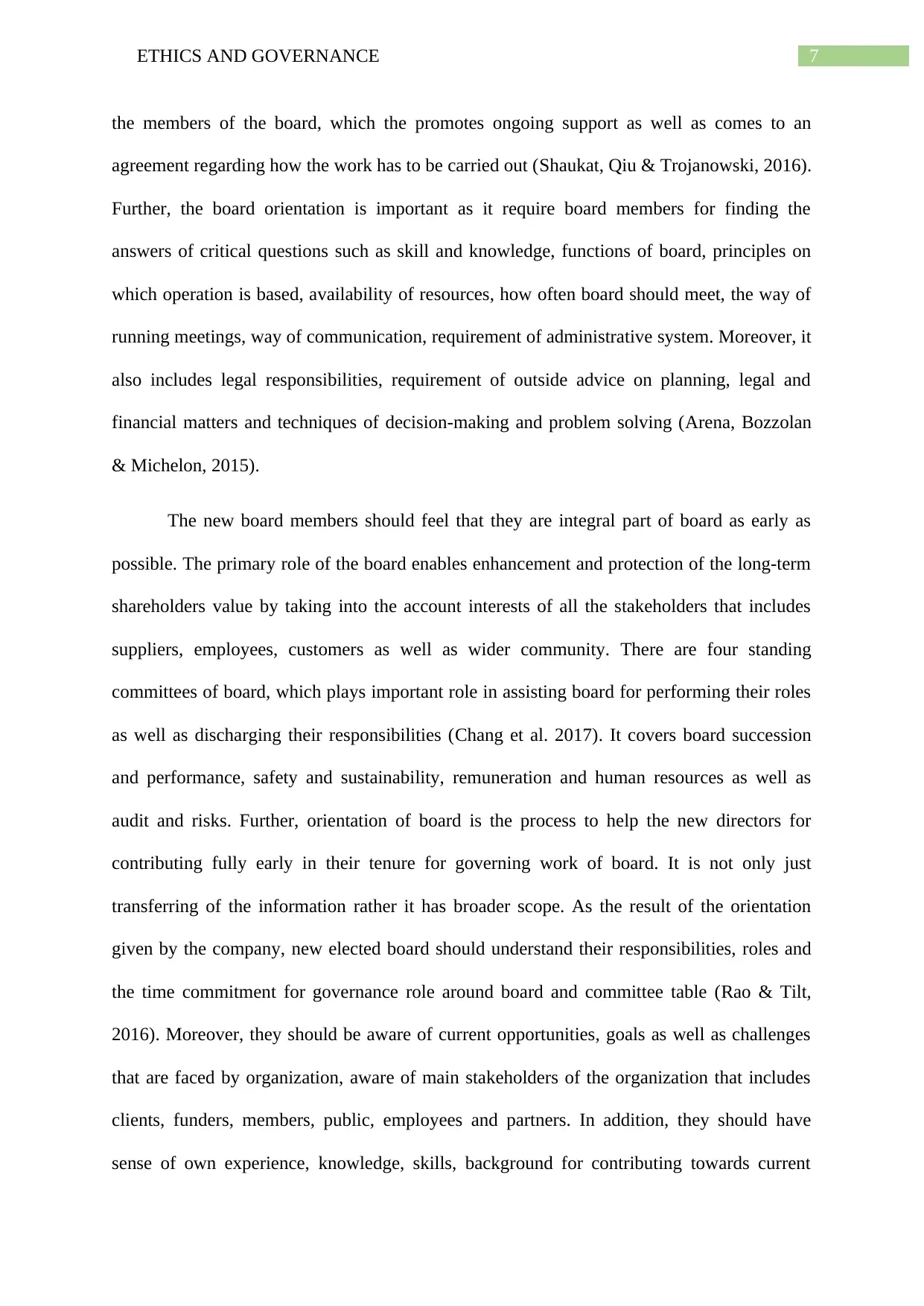
7ETHICS AND GOVERNANCE
the members of the board, which the promotes ongoing support as well as comes to an
agreement regarding how the work has to be carried out (Shaukat, Qiu & Trojanowski, 2016).
Further, the board orientation is important as it require board members for finding the
answers of critical questions such as skill and knowledge, functions of board, principles on
which operation is based, availability of resources, how often board should meet, the way of
running meetings, way of communication, requirement of administrative system. Moreover, it
also includes legal responsibilities, requirement of outside advice on planning, legal and
financial matters and techniques of decision-making and problem solving (Arena, Bozzolan
& Michelon, 2015).
The new board members should feel that they are integral part of board as early as
possible. The primary role of the board enables enhancement and protection of the long-term
shareholders value by taking into the account interests of all the stakeholders that includes
suppliers, employees, customers as well as wider community. There are four standing
committees of board, which plays important role in assisting board for performing their roles
as well as discharging their responsibilities (Chang et al. 2017). It covers board succession
and performance, safety and sustainability, remuneration and human resources as well as
audit and risks. Further, orientation of board is the process to help the new directors for
contributing fully early in their tenure for governing work of board. It is not only just
transferring of the information rather it has broader scope. As the result of the orientation
given by the company, new elected board should understand their responsibilities, roles and
the time commitment for governance role around board and committee table (Rao & Tilt,
2016). Moreover, they should be aware of current opportunities, goals as well as challenges
that are faced by organization, aware of main stakeholders of the organization that includes
clients, funders, members, public, employees and partners. In addition, they should have
sense of own experience, knowledge, skills, background for contributing towards current
the members of the board, which the promotes ongoing support as well as comes to an
agreement regarding how the work has to be carried out (Shaukat, Qiu & Trojanowski, 2016).
Further, the board orientation is important as it require board members for finding the
answers of critical questions such as skill and knowledge, functions of board, principles on
which operation is based, availability of resources, how often board should meet, the way of
running meetings, way of communication, requirement of administrative system. Moreover, it
also includes legal responsibilities, requirement of outside advice on planning, legal and
financial matters and techniques of decision-making and problem solving (Arena, Bozzolan
& Michelon, 2015).
The new board members should feel that they are integral part of board as early as
possible. The primary role of the board enables enhancement and protection of the long-term
shareholders value by taking into the account interests of all the stakeholders that includes
suppliers, employees, customers as well as wider community. There are four standing
committees of board, which plays important role in assisting board for performing their roles
as well as discharging their responsibilities (Chang et al. 2017). It covers board succession
and performance, safety and sustainability, remuneration and human resources as well as
audit and risks. Further, orientation of board is the process to help the new directors for
contributing fully early in their tenure for governing work of board. It is not only just
transferring of the information rather it has broader scope. As the result of the orientation
given by the company, new elected board should understand their responsibilities, roles and
the time commitment for governance role around board and committee table (Rao & Tilt,
2016). Moreover, they should be aware of current opportunities, goals as well as challenges
that are faced by organization, aware of main stakeholders of the organization that includes
clients, funders, members, public, employees and partners. In addition, they should have
sense of own experience, knowledge, skills, background for contributing towards current
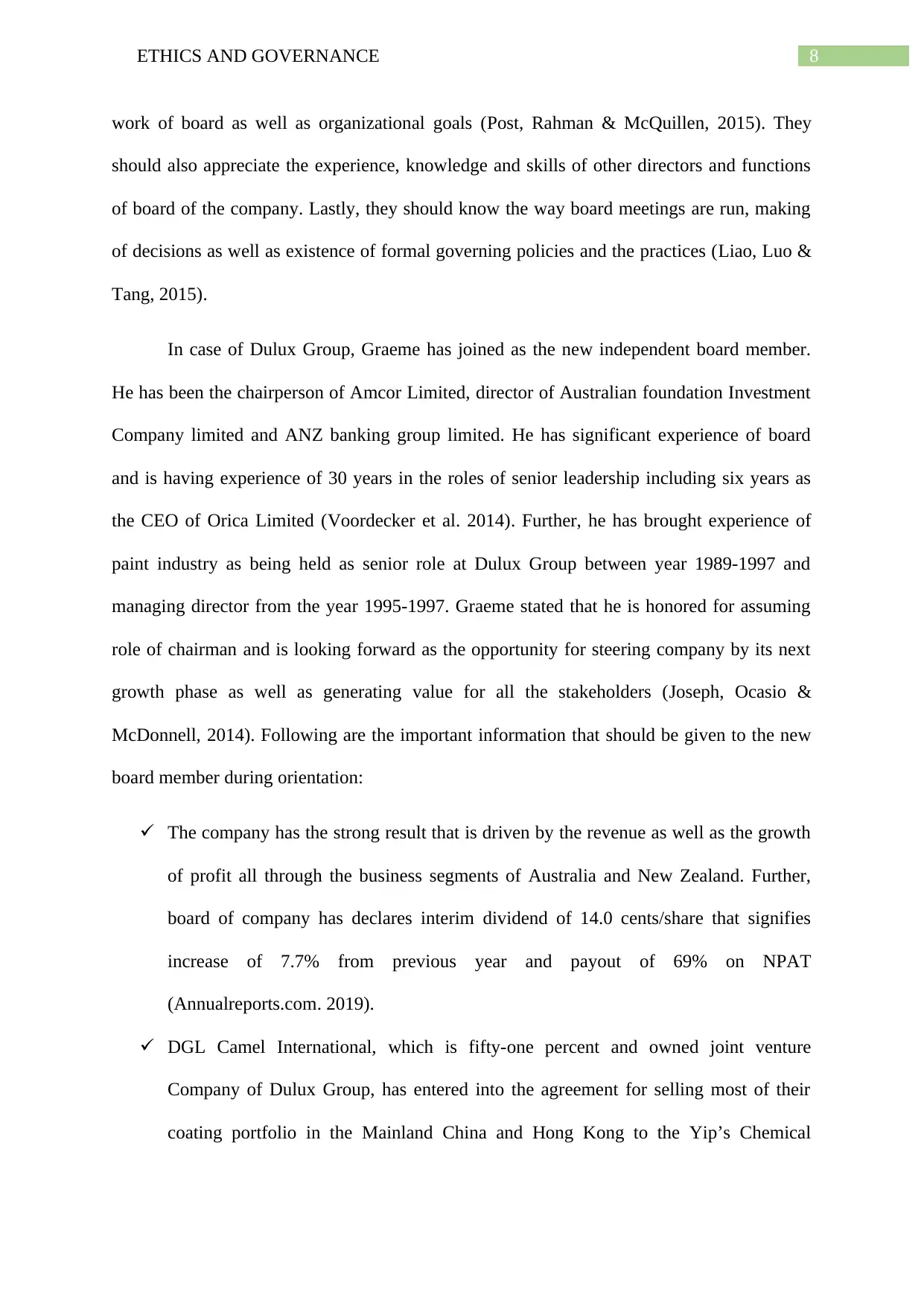
8ETHICS AND GOVERNANCE
work of board as well as organizational goals (Post, Rahman & McQuillen, 2015). They
should also appreciate the experience, knowledge and skills of other directors and functions
of board of the company. Lastly, they should know the way board meetings are run, making
of decisions as well as existence of formal governing policies and the practices (Liao, Luo &
Tang, 2015).
In case of Dulux Group, Graeme has joined as the new independent board member.
He has been the chairperson of Amcor Limited, director of Australian foundation Investment
Company limited and ANZ banking group limited. He has significant experience of board
and is having experience of 30 years in the roles of senior leadership including six years as
the CEO of Orica Limited (Voordecker et al. 2014). Further, he has brought experience of
paint industry as being held as senior role at Dulux Group between year 1989-1997 and
managing director from the year 1995-1997. Graeme stated that he is honored for assuming
role of chairman and is looking forward as the opportunity for steering company by its next
growth phase as well as generating value for all the stakeholders (Joseph, Ocasio &
McDonnell, 2014). Following are the important information that should be given to the new
board member during orientation:
The company has the strong result that is driven by the revenue as well as the growth
of profit all through the business segments of Australia and New Zealand. Further,
board of company has declares interim dividend of 14.0 cents/share that signifies
increase of 7.7% from previous year and payout of 69% on NPAT
(Annualreports.com. 2019).
DGL Camel International, which is fifty-one percent and owned joint venture
Company of Dulux Group, has entered into the agreement for selling most of their
coating portfolio in the Mainland China and Hong Kong to the Yip’s Chemical
work of board as well as organizational goals (Post, Rahman & McQuillen, 2015). They
should also appreciate the experience, knowledge and skills of other directors and functions
of board of the company. Lastly, they should know the way board meetings are run, making
of decisions as well as existence of formal governing policies and the practices (Liao, Luo &
Tang, 2015).
In case of Dulux Group, Graeme has joined as the new independent board member.
He has been the chairperson of Amcor Limited, director of Australian foundation Investment
Company limited and ANZ banking group limited. He has significant experience of board
and is having experience of 30 years in the roles of senior leadership including six years as
the CEO of Orica Limited (Voordecker et al. 2014). Further, he has brought experience of
paint industry as being held as senior role at Dulux Group between year 1989-1997 and
managing director from the year 1995-1997. Graeme stated that he is honored for assuming
role of chairman and is looking forward as the opportunity for steering company by its next
growth phase as well as generating value for all the stakeholders (Joseph, Ocasio &
McDonnell, 2014). Following are the important information that should be given to the new
board member during orientation:
The company has the strong result that is driven by the revenue as well as the growth
of profit all through the business segments of Australia and New Zealand. Further,
board of company has declares interim dividend of 14.0 cents/share that signifies
increase of 7.7% from previous year and payout of 69% on NPAT
(Annualreports.com. 2019).
DGL Camel International, which is fifty-one percent and owned joint venture
Company of Dulux Group, has entered into the agreement for selling most of their
coating portfolio in the Mainland China and Hong Kong to the Yip’s Chemical
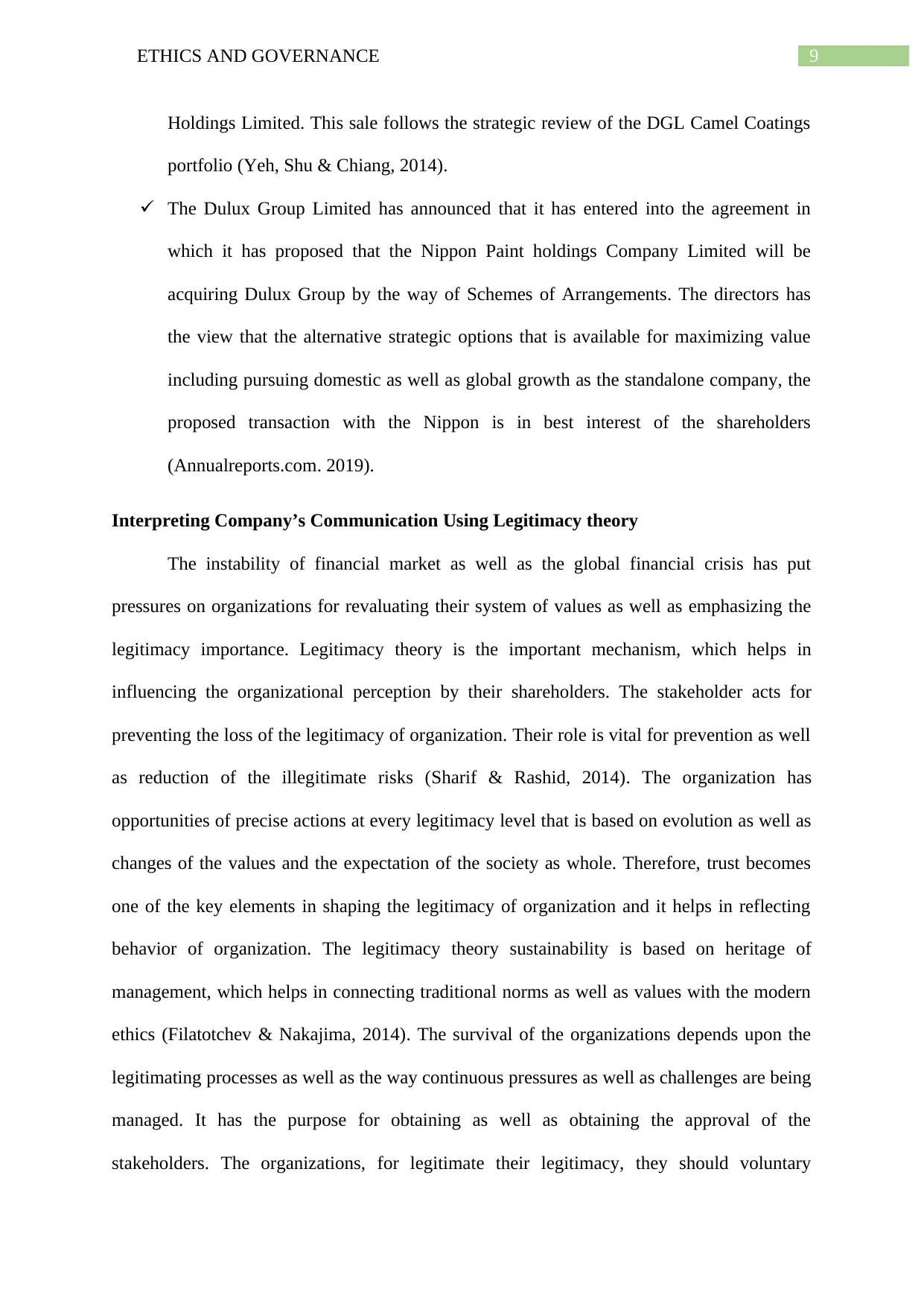
9ETHICS AND GOVERNANCE
Holdings Limited. This sale follows the strategic review of the DGL Camel Coatings
portfolio (Yeh, Shu & Chiang, 2014).
The Dulux Group Limited has announced that it has entered into the agreement in
which it has proposed that the Nippon Paint holdings Company Limited will be
acquiring Dulux Group by the way of Schemes of Arrangements. The directors has
the view that the alternative strategic options that is available for maximizing value
including pursuing domestic as well as global growth as the standalone company, the
proposed transaction with the Nippon is in best interest of the shareholders
(Annualreports.com. 2019).
Interpreting Company’s Communication Using Legitimacy theory
The instability of financial market as well as the global financial crisis has put
pressures on organizations for revaluating their system of values as well as emphasizing the
legitimacy importance. Legitimacy theory is the important mechanism, which helps in
influencing the organizational perception by their shareholders. The stakeholder acts for
preventing the loss of the legitimacy of organization. Their role is vital for prevention as well
as reduction of the illegitimate risks (Sharif & Rashid, 2014). The organization has
opportunities of precise actions at every legitimacy level that is based on evolution as well as
changes of the values and the expectation of the society as whole. Therefore, trust becomes
one of the key elements in shaping the legitimacy of organization and it helps in reflecting
behavior of organization. The legitimacy theory sustainability is based on heritage of
management, which helps in connecting traditional norms as well as values with the modern
ethics (Filatotchev & Nakajima, 2014). The survival of the organizations depends upon the
legitimating processes as well as the way continuous pressures as well as challenges are being
managed. It has the purpose for obtaining as well as obtaining the approval of the
stakeholders. The organizations, for legitimate their legitimacy, they should voluntary
Holdings Limited. This sale follows the strategic review of the DGL Camel Coatings
portfolio (Yeh, Shu & Chiang, 2014).
The Dulux Group Limited has announced that it has entered into the agreement in
which it has proposed that the Nippon Paint holdings Company Limited will be
acquiring Dulux Group by the way of Schemes of Arrangements. The directors has
the view that the alternative strategic options that is available for maximizing value
including pursuing domestic as well as global growth as the standalone company, the
proposed transaction with the Nippon is in best interest of the shareholders
(Annualreports.com. 2019).
Interpreting Company’s Communication Using Legitimacy theory
The instability of financial market as well as the global financial crisis has put
pressures on organizations for revaluating their system of values as well as emphasizing the
legitimacy importance. Legitimacy theory is the important mechanism, which helps in
influencing the organizational perception by their shareholders. The stakeholder acts for
preventing the loss of the legitimacy of organization. Their role is vital for prevention as well
as reduction of the illegitimate risks (Sharif & Rashid, 2014). The organization has
opportunities of precise actions at every legitimacy level that is based on evolution as well as
changes of the values and the expectation of the society as whole. Therefore, trust becomes
one of the key elements in shaping the legitimacy of organization and it helps in reflecting
behavior of organization. The legitimacy theory sustainability is based on heritage of
management, which helps in connecting traditional norms as well as values with the modern
ethics (Filatotchev & Nakajima, 2014). The survival of the organizations depends upon the
legitimating processes as well as the way continuous pressures as well as challenges are being
managed. It has the purpose for obtaining as well as obtaining the approval of the
stakeholders. The organizations, for legitimate their legitimacy, they should voluntary
Secure Best Marks with AI Grader
Need help grading? Try our AI Grader for instant feedback on your assignments.
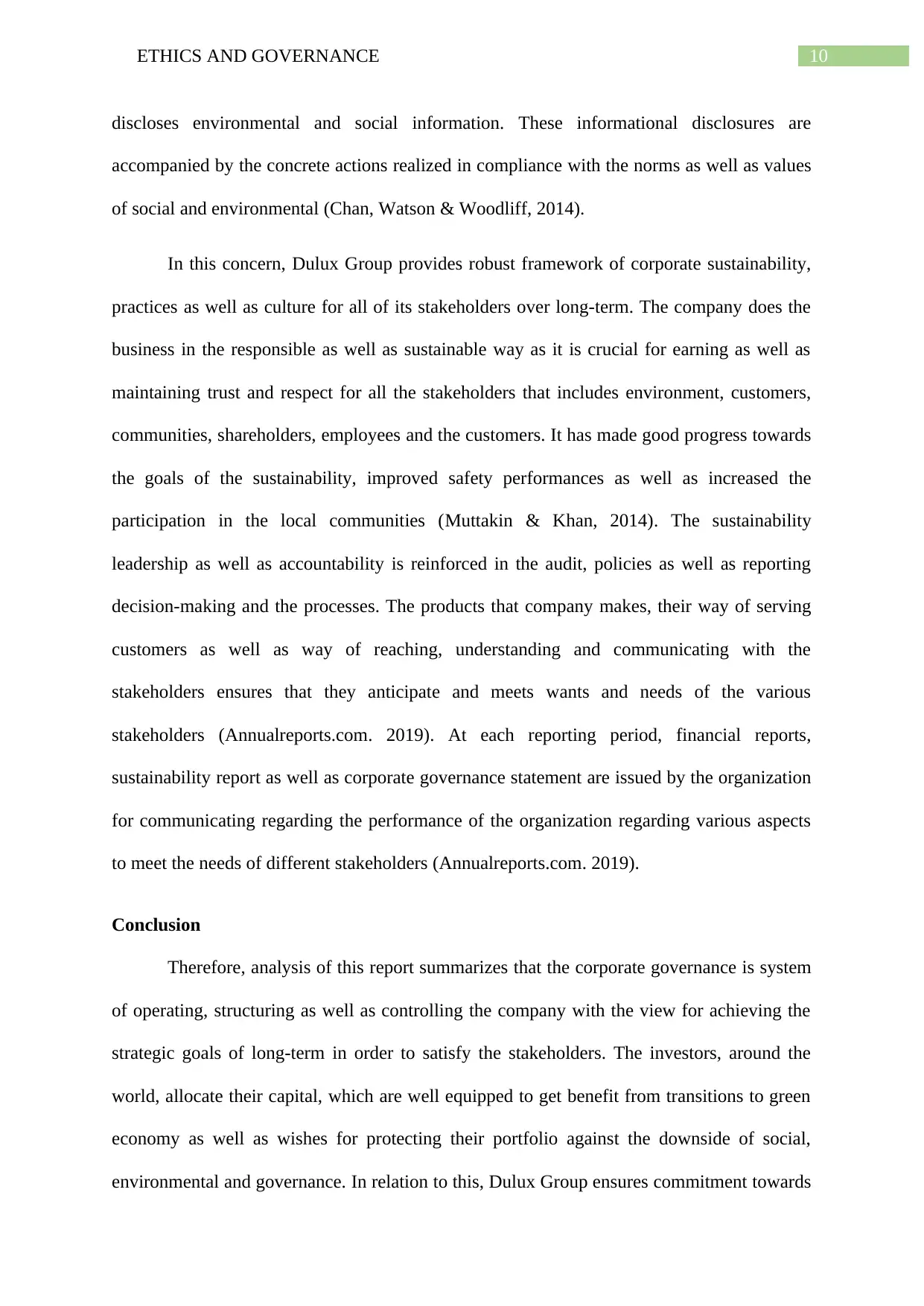
10ETHICS AND GOVERNANCE
discloses environmental and social information. These informational disclosures are
accompanied by the concrete actions realized in compliance with the norms as well as values
of social and environmental (Chan, Watson & Woodliff, 2014).
In this concern, Dulux Group provides robust framework of corporate sustainability,
practices as well as culture for all of its stakeholders over long-term. The company does the
business in the responsible as well as sustainable way as it is crucial for earning as well as
maintaining trust and respect for all the stakeholders that includes environment, customers,
communities, shareholders, employees and the customers. It has made good progress towards
the goals of the sustainability, improved safety performances as well as increased the
participation in the local communities (Muttakin & Khan, 2014). The sustainability
leadership as well as accountability is reinforced in the audit, policies as well as reporting
decision-making and the processes. The products that company makes, their way of serving
customers as well as way of reaching, understanding and communicating with the
stakeholders ensures that they anticipate and meets wants and needs of the various
stakeholders (Annualreports.com. 2019). At each reporting period, financial reports,
sustainability report as well as corporate governance statement are issued by the organization
for communicating regarding the performance of the organization regarding various aspects
to meet the needs of different stakeholders (Annualreports.com. 2019).
Conclusion
Therefore, analysis of this report summarizes that the corporate governance is system
of operating, structuring as well as controlling the company with the view for achieving the
strategic goals of long-term in order to satisfy the stakeholders. The investors, around the
world, allocate their capital, which are well equipped to get benefit from transitions to green
economy as well as wishes for protecting their portfolio against the downside of social,
environmental and governance. In relation to this, Dulux Group ensures commitment towards
discloses environmental and social information. These informational disclosures are
accompanied by the concrete actions realized in compliance with the norms as well as values
of social and environmental (Chan, Watson & Woodliff, 2014).
In this concern, Dulux Group provides robust framework of corporate sustainability,
practices as well as culture for all of its stakeholders over long-term. The company does the
business in the responsible as well as sustainable way as it is crucial for earning as well as
maintaining trust and respect for all the stakeholders that includes environment, customers,
communities, shareholders, employees and the customers. It has made good progress towards
the goals of the sustainability, improved safety performances as well as increased the
participation in the local communities (Muttakin & Khan, 2014). The sustainability
leadership as well as accountability is reinforced in the audit, policies as well as reporting
decision-making and the processes. The products that company makes, their way of serving
customers as well as way of reaching, understanding and communicating with the
stakeholders ensures that they anticipate and meets wants and needs of the various
stakeholders (Annualreports.com. 2019). At each reporting period, financial reports,
sustainability report as well as corporate governance statement are issued by the organization
for communicating regarding the performance of the organization regarding various aspects
to meet the needs of different stakeholders (Annualreports.com. 2019).
Conclusion
Therefore, analysis of this report summarizes that the corporate governance is system
of operating, structuring as well as controlling the company with the view for achieving the
strategic goals of long-term in order to satisfy the stakeholders. The investors, around the
world, allocate their capital, which are well equipped to get benefit from transitions to green
economy as well as wishes for protecting their portfolio against the downside of social,
environmental and governance. In relation to this, Dulux Group ensures commitment towards
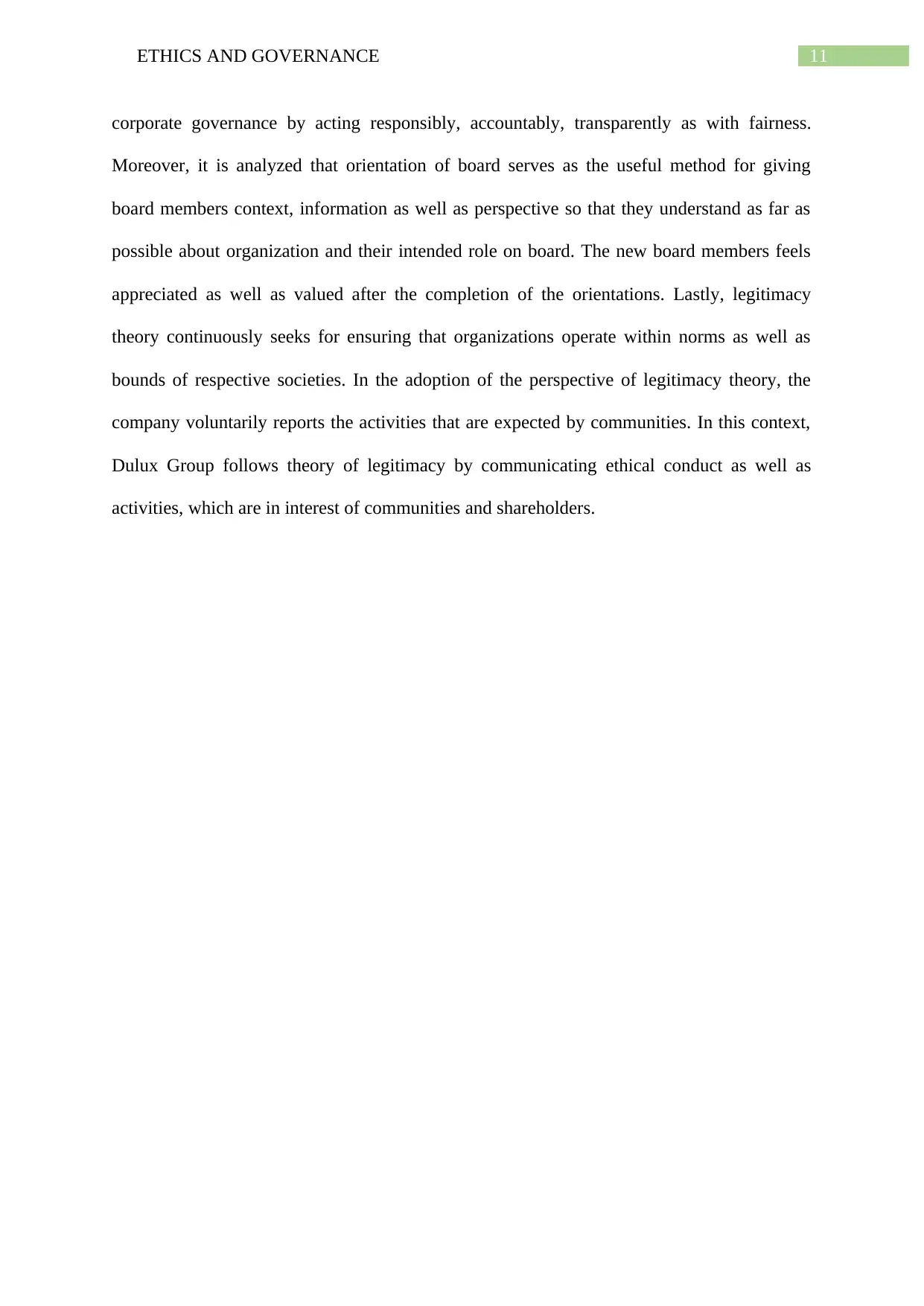
11ETHICS AND GOVERNANCE
corporate governance by acting responsibly, accountably, transparently as with fairness.
Moreover, it is analyzed that orientation of board serves as the useful method for giving
board members context, information as well as perspective so that they understand as far as
possible about organization and their intended role on board. The new board members feels
appreciated as well as valued after the completion of the orientations. Lastly, legitimacy
theory continuously seeks for ensuring that organizations operate within norms as well as
bounds of respective societies. In the adoption of the perspective of legitimacy theory, the
company voluntarily reports the activities that are expected by communities. In this context,
Dulux Group follows theory of legitimacy by communicating ethical conduct as well as
activities, which are in interest of communities and shareholders.
corporate governance by acting responsibly, accountably, transparently as with fairness.
Moreover, it is analyzed that orientation of board serves as the useful method for giving
board members context, information as well as perspective so that they understand as far as
possible about organization and their intended role on board. The new board members feels
appreciated as well as valued after the completion of the orientations. Lastly, legitimacy
theory continuously seeks for ensuring that organizations operate within norms as well as
bounds of respective societies. In the adoption of the perspective of legitimacy theory, the
company voluntarily reports the activities that are expected by communities. In this context,
Dulux Group follows theory of legitimacy by communicating ethical conduct as well as
activities, which are in interest of communities and shareholders.
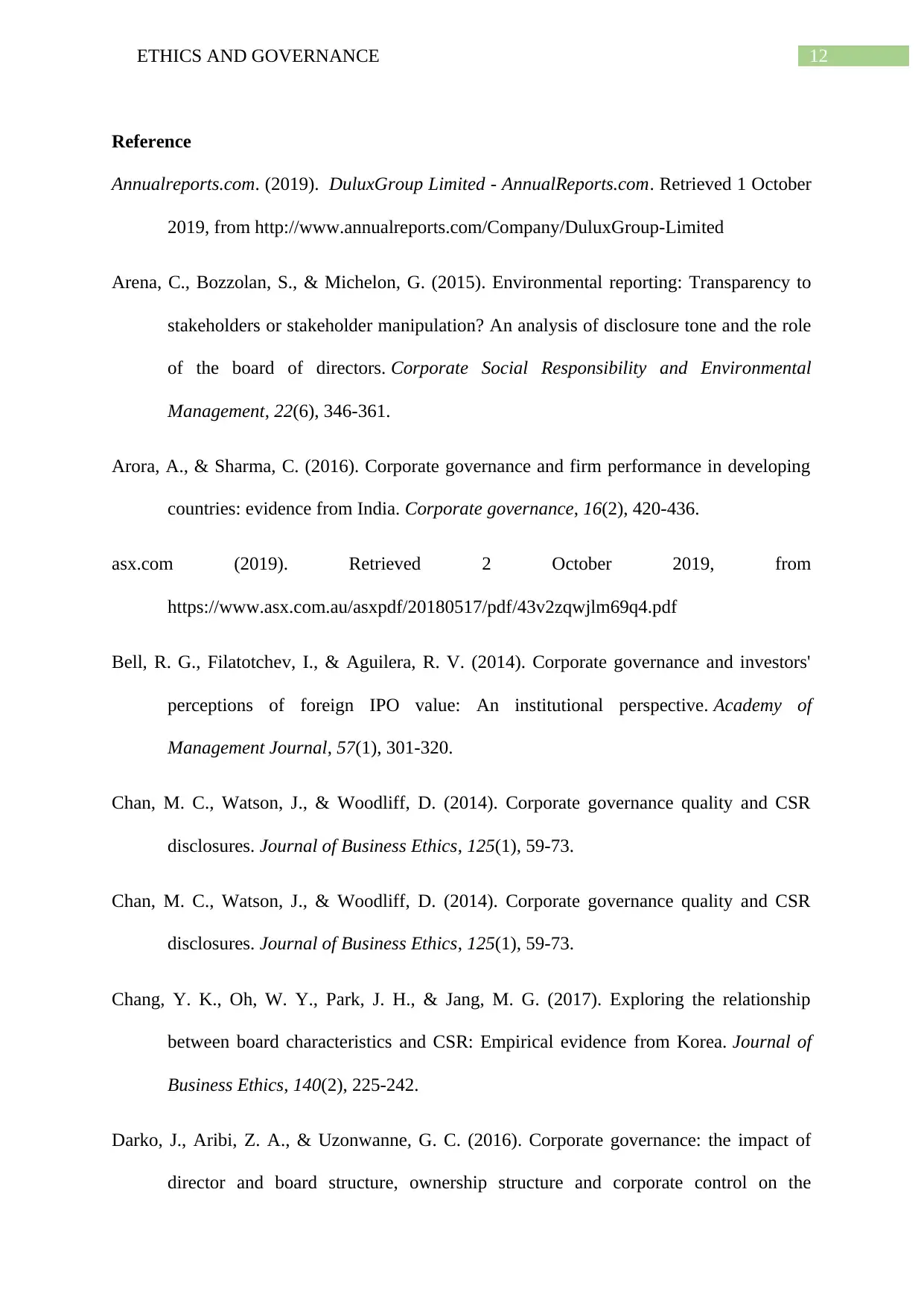
12ETHICS AND GOVERNANCE
Reference
Annualreports.com. (2019). DuluxGroup Limited - AnnualReports.com. Retrieved 1 October
2019, from http://www.annualreports.com/Company/DuluxGroup-Limited
Arena, C., Bozzolan, S., & Michelon, G. (2015). Environmental reporting: Transparency to
stakeholders or stakeholder manipulation? An analysis of disclosure tone and the role
of the board of directors. Corporate Social Responsibility and Environmental
Management, 22(6), 346-361.
Arora, A., & Sharma, C. (2016). Corporate governance and firm performance in developing
countries: evidence from India. Corporate governance, 16(2), 420-436.
asx.com (2019). Retrieved 2 October 2019, from
https://www.asx.com.au/asxpdf/20180517/pdf/43v2zqwjlm69q4.pdf
Bell, R. G., Filatotchev, I., & Aguilera, R. V. (2014). Corporate governance and investors'
perceptions of foreign IPO value: An institutional perspective. Academy of
Management Journal, 57(1), 301-320.
Chan, M. C., Watson, J., & Woodliff, D. (2014). Corporate governance quality and CSR
disclosures. Journal of Business Ethics, 125(1), 59-73.
Chan, M. C., Watson, J., & Woodliff, D. (2014). Corporate governance quality and CSR
disclosures. Journal of Business Ethics, 125(1), 59-73.
Chang, Y. K., Oh, W. Y., Park, J. H., & Jang, M. G. (2017). Exploring the relationship
between board characteristics and CSR: Empirical evidence from Korea. Journal of
Business Ethics, 140(2), 225-242.
Darko, J., Aribi, Z. A., & Uzonwanne, G. C. (2016). Corporate governance: the impact of
director and board structure, ownership structure and corporate control on the
Reference
Annualreports.com. (2019). DuluxGroup Limited - AnnualReports.com. Retrieved 1 October
2019, from http://www.annualreports.com/Company/DuluxGroup-Limited
Arena, C., Bozzolan, S., & Michelon, G. (2015). Environmental reporting: Transparency to
stakeholders or stakeholder manipulation? An analysis of disclosure tone and the role
of the board of directors. Corporate Social Responsibility and Environmental
Management, 22(6), 346-361.
Arora, A., & Sharma, C. (2016). Corporate governance and firm performance in developing
countries: evidence from India. Corporate governance, 16(2), 420-436.
asx.com (2019). Retrieved 2 October 2019, from
https://www.asx.com.au/asxpdf/20180517/pdf/43v2zqwjlm69q4.pdf
Bell, R. G., Filatotchev, I., & Aguilera, R. V. (2014). Corporate governance and investors'
perceptions of foreign IPO value: An institutional perspective. Academy of
Management Journal, 57(1), 301-320.
Chan, M. C., Watson, J., & Woodliff, D. (2014). Corporate governance quality and CSR
disclosures. Journal of Business Ethics, 125(1), 59-73.
Chan, M. C., Watson, J., & Woodliff, D. (2014). Corporate governance quality and CSR
disclosures. Journal of Business Ethics, 125(1), 59-73.
Chang, Y. K., Oh, W. Y., Park, J. H., & Jang, M. G. (2017). Exploring the relationship
between board characteristics and CSR: Empirical evidence from Korea. Journal of
Business Ethics, 140(2), 225-242.
Darko, J., Aribi, Z. A., & Uzonwanne, G. C. (2016). Corporate governance: the impact of
director and board structure, ownership structure and corporate control on the
Paraphrase This Document
Need a fresh take? Get an instant paraphrase of this document with our AI Paraphraser
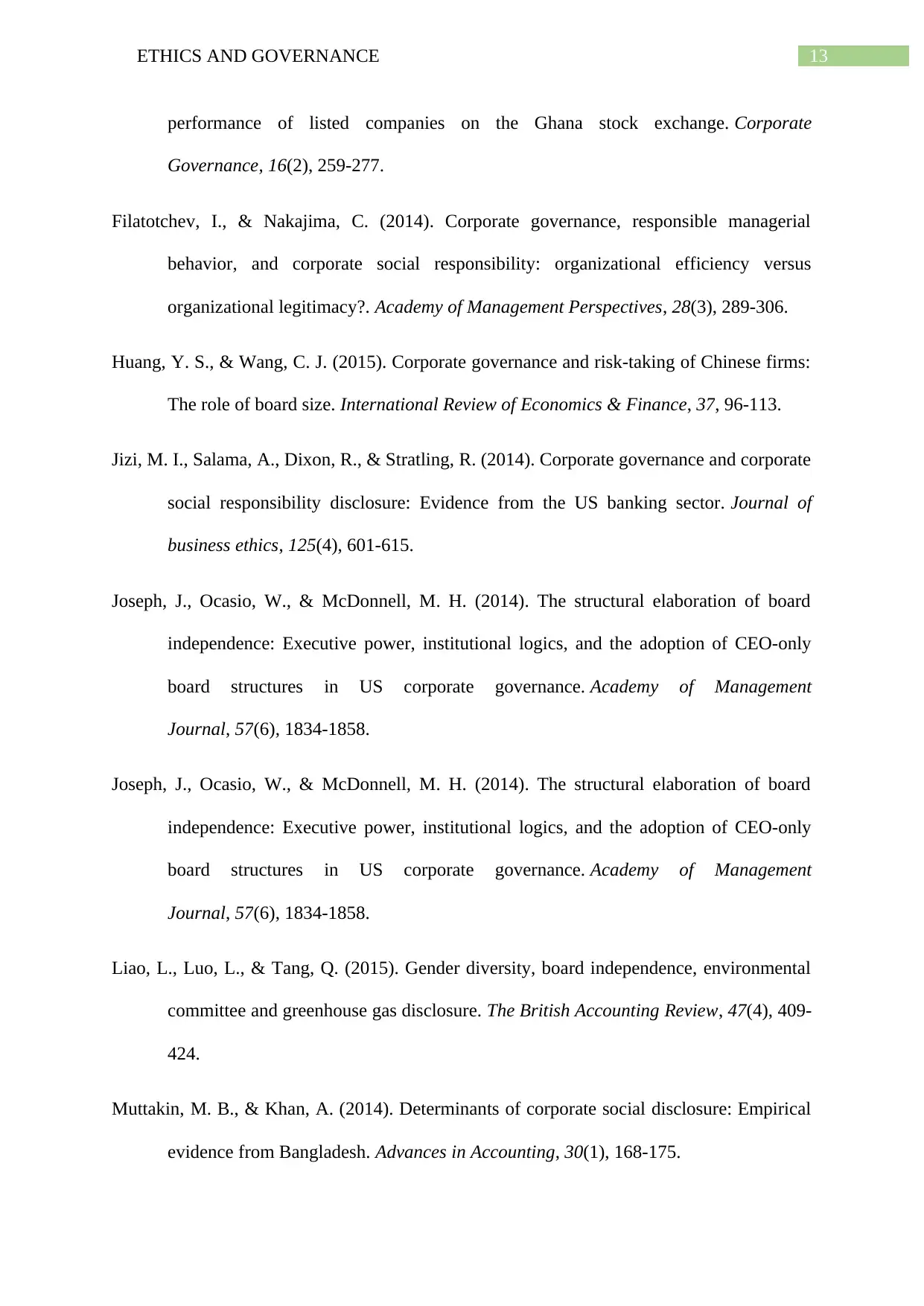
13ETHICS AND GOVERNANCE
performance of listed companies on the Ghana stock exchange. Corporate
Governance, 16(2), 259-277.
Filatotchev, I., & Nakajima, C. (2014). Corporate governance, responsible managerial
behavior, and corporate social responsibility: organizational efficiency versus
organizational legitimacy?. Academy of Management Perspectives, 28(3), 289-306.
Huang, Y. S., & Wang, C. J. (2015). Corporate governance and risk-taking of Chinese firms:
The role of board size. International Review of Economics & Finance, 37, 96-113.
Jizi, M. I., Salama, A., Dixon, R., & Stratling, R. (2014). Corporate governance and corporate
social responsibility disclosure: Evidence from the US banking sector. Journal of
business ethics, 125(4), 601-615.
Joseph, J., Ocasio, W., & McDonnell, M. H. (2014). The structural elaboration of board
independence: Executive power, institutional logics, and the adoption of CEO-only
board structures in US corporate governance. Academy of Management
Journal, 57(6), 1834-1858.
Joseph, J., Ocasio, W., & McDonnell, M. H. (2014). The structural elaboration of board
independence: Executive power, institutional logics, and the adoption of CEO-only
board structures in US corporate governance. Academy of Management
Journal, 57(6), 1834-1858.
Liao, L., Luo, L., & Tang, Q. (2015). Gender diversity, board independence, environmental
committee and greenhouse gas disclosure. The British Accounting Review, 47(4), 409-
424.
Muttakin, M. B., & Khan, A. (2014). Determinants of corporate social disclosure: Empirical
evidence from Bangladesh. Advances in Accounting, 30(1), 168-175.
performance of listed companies on the Ghana stock exchange. Corporate
Governance, 16(2), 259-277.
Filatotchev, I., & Nakajima, C. (2014). Corporate governance, responsible managerial
behavior, and corporate social responsibility: organizational efficiency versus
organizational legitimacy?. Academy of Management Perspectives, 28(3), 289-306.
Huang, Y. S., & Wang, C. J. (2015). Corporate governance and risk-taking of Chinese firms:
The role of board size. International Review of Economics & Finance, 37, 96-113.
Jizi, M. I., Salama, A., Dixon, R., & Stratling, R. (2014). Corporate governance and corporate
social responsibility disclosure: Evidence from the US banking sector. Journal of
business ethics, 125(4), 601-615.
Joseph, J., Ocasio, W., & McDonnell, M. H. (2014). The structural elaboration of board
independence: Executive power, institutional logics, and the adoption of CEO-only
board structures in US corporate governance. Academy of Management
Journal, 57(6), 1834-1858.
Joseph, J., Ocasio, W., & McDonnell, M. H. (2014). The structural elaboration of board
independence: Executive power, institutional logics, and the adoption of CEO-only
board structures in US corporate governance. Academy of Management
Journal, 57(6), 1834-1858.
Liao, L., Luo, L., & Tang, Q. (2015). Gender diversity, board independence, environmental
committee and greenhouse gas disclosure. The British Accounting Review, 47(4), 409-
424.
Muttakin, M. B., & Khan, A. (2014). Determinants of corporate social disclosure: Empirical
evidence from Bangladesh. Advances in Accounting, 30(1), 168-175.
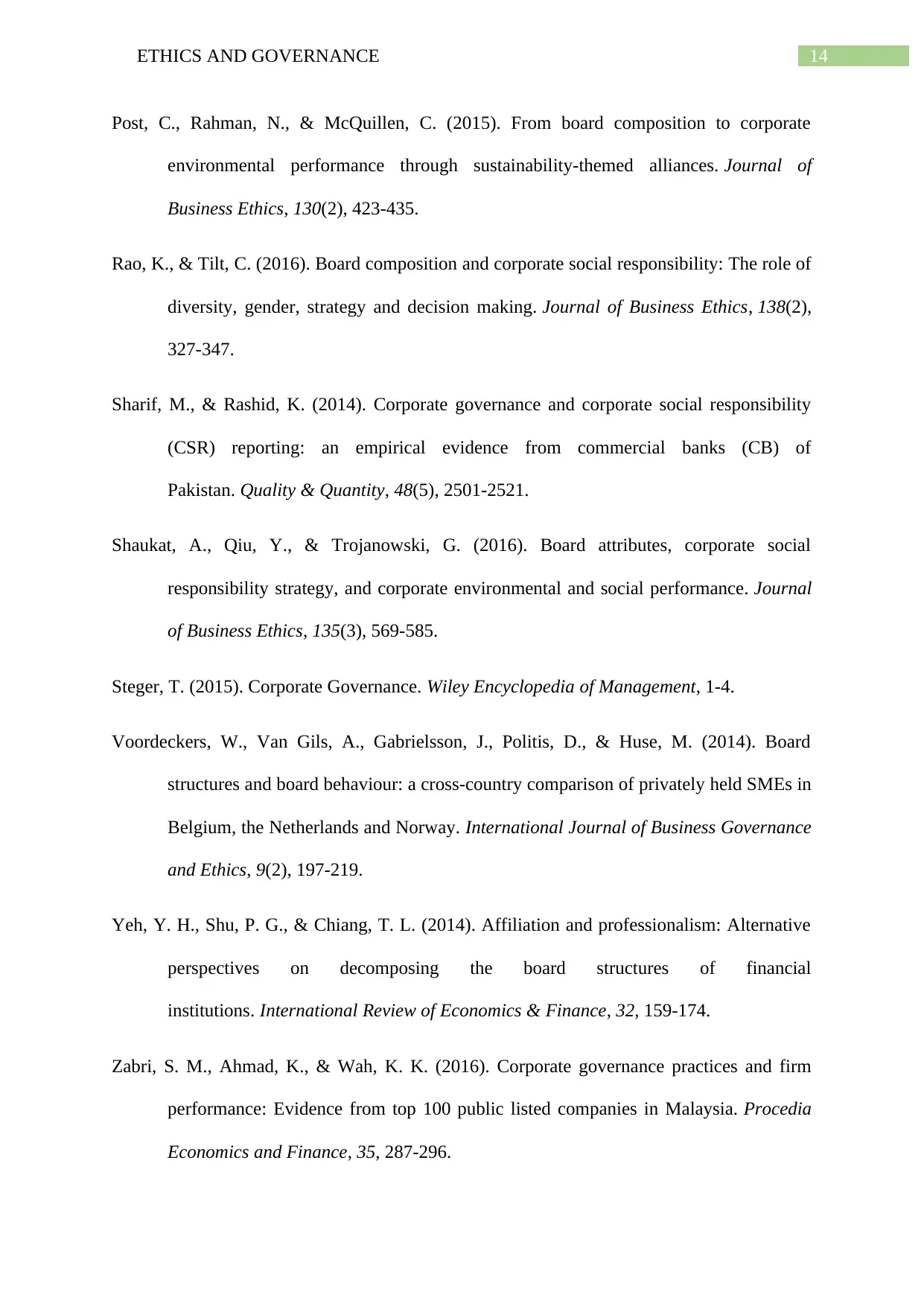
14ETHICS AND GOVERNANCE
Post, C., Rahman, N., & McQuillen, C. (2015). From board composition to corporate
environmental performance through sustainability-themed alliances. Journal of
Business Ethics, 130(2), 423-435.
Rao, K., & Tilt, C. (2016). Board composition and corporate social responsibility: The role of
diversity, gender, strategy and decision making. Journal of Business Ethics, 138(2),
327-347.
Sharif, M., & Rashid, K. (2014). Corporate governance and corporate social responsibility
(CSR) reporting: an empirical evidence from commercial banks (CB) of
Pakistan. Quality & Quantity, 48(5), 2501-2521.
Shaukat, A., Qiu, Y., & Trojanowski, G. (2016). Board attributes, corporate social
responsibility strategy, and corporate environmental and social performance. Journal
of Business Ethics, 135(3), 569-585.
Steger, T. (2015). Corporate Governance. Wiley Encyclopedia of Management, 1-4.
Voordeckers, W., Van Gils, A., Gabrielsson, J., Politis, D., & Huse, M. (2014). Board
structures and board behaviour: a cross-country comparison of privately held SMEs in
Belgium, the Netherlands and Norway. International Journal of Business Governance
and Ethics, 9(2), 197-219.
Yeh, Y. H., Shu, P. G., & Chiang, T. L. (2014). Affiliation and professionalism: Alternative
perspectives on decomposing the board structures of financial
institutions. International Review of Economics & Finance, 32, 159-174.
Zabri, S. M., Ahmad, K., & Wah, K. K. (2016). Corporate governance practices and firm
performance: Evidence from top 100 public listed companies in Malaysia. Procedia
Economics and Finance, 35, 287-296.
Post, C., Rahman, N., & McQuillen, C. (2015). From board composition to corporate
environmental performance through sustainability-themed alliances. Journal of
Business Ethics, 130(2), 423-435.
Rao, K., & Tilt, C. (2016). Board composition and corporate social responsibility: The role of
diversity, gender, strategy and decision making. Journal of Business Ethics, 138(2),
327-347.
Sharif, M., & Rashid, K. (2014). Corporate governance and corporate social responsibility
(CSR) reporting: an empirical evidence from commercial banks (CB) of
Pakistan. Quality & Quantity, 48(5), 2501-2521.
Shaukat, A., Qiu, Y., & Trojanowski, G. (2016). Board attributes, corporate social
responsibility strategy, and corporate environmental and social performance. Journal
of Business Ethics, 135(3), 569-585.
Steger, T. (2015). Corporate Governance. Wiley Encyclopedia of Management, 1-4.
Voordeckers, W., Van Gils, A., Gabrielsson, J., Politis, D., & Huse, M. (2014). Board
structures and board behaviour: a cross-country comparison of privately held SMEs in
Belgium, the Netherlands and Norway. International Journal of Business Governance
and Ethics, 9(2), 197-219.
Yeh, Y. H., Shu, P. G., & Chiang, T. L. (2014). Affiliation and professionalism: Alternative
perspectives on decomposing the board structures of financial
institutions. International Review of Economics & Finance, 32, 159-174.
Zabri, S. M., Ahmad, K., & Wah, K. K. (2016). Corporate governance practices and firm
performance: Evidence from top 100 public listed companies in Malaysia. Procedia
Economics and Finance, 35, 287-296.
1 out of 15
Related Documents
Your All-in-One AI-Powered Toolkit for Academic Success.
+13062052269
info@desklib.com
Available 24*7 on WhatsApp / Email
![[object Object]](/_next/static/media/star-bottom.7253800d.svg)
Unlock your academic potential
© 2024 | Zucol Services PVT LTD | All rights reserved.





